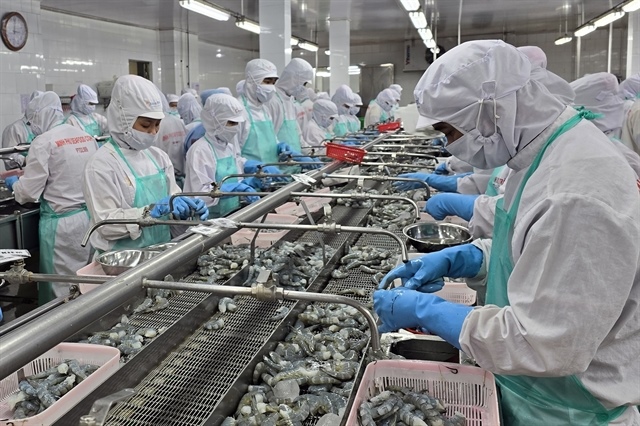Seafood exports face mounting uncertainty in H1
Seafood exports face mounting uncertainty in H1
Exporters and trade analysts are now warning of a more turbulent path ahead for the remainder of the year as the Government is being urged to provide timely support through preferential credit access, real-time market intelligence, and trade promotion campaigns focused on alternative markets.

A frozen shrimp processing line for export at Minh Phú Seafood Corporation in Cà Mau Province. VNA Photo |
Việt Nam’s seafood export sector, which had shown a strong performance early this year, is now beginning to slow as geopolitical instability and tariff uncertainties start to take their toll.
Exporters and trade analysts are now warning of a more turbulent path ahead for the remainder of the year.
According to the Việt Nam Association of Seafood Exporters and Producers (VASEP), seafood export turnover in June reached US$876 million, a modest rise of 4 per cent year-on-year.
This marks the weakest monthly growth rate since the beginning of the year, a stark contrast to the robust 20 per cent increase recorded in May.
Total seafood export value for the first six months of this year stood at approximately $5.2 billion, or about 19 per cent increase over the same period of last year.
The US remained one of Việt Nam’s top importers, with a turnover of $891 million.
However, concerns about looming trade retaliation measures have prompted many Vietnamese exporters to temporarily halt shipments to the US since June, aiming to minimise exposure to risk.
In contrast, exports to China, Japan, South Korea, and the ASEAN bloc continued their positive trajectory, recording growth rates ranging from 15 per cent to nearly 28 per cent in June alone.
Meanwhile, the European Union market has shown signs of stagnation, dipping slightly by 1 per cent, and exports to the Middle East fell sharply by 16 per cent due to escalating regional tensions. Particularly alarming was a more than 50 per cent drop in exports to Israel, a key market for canned tuna.
Mounting trade pressure
Among key product groups, tuna experienced the steepest decline in June, plunging by over 31 per cent year-on-year.
This fall is largely attributed to tariff barriers imposed by the US, where tuna accounts for a significant share of seafood imports from Việt Nam. Overall, tuna exports for the first half of the year dropped nearly 2 per cent.
Other staples such as shrimp and pangasius (cá tra) also saw their growth slowing.
By the end of June, shrimp exports reached $2.07 billion, an increase of 26 per cent over the same period last year. Pangasius exports climbed 10 per cent to $1 billion.
VASEP Deputy General Secretary Lê Hằng noted that the outlook for shrimp and pangasius exports in the second half of 2025 would hinge almost entirely on how the US applies its upcoming retaliatory tariff measures.
“Shrimp faces a real threat of overlapping taxes – including retaliatory tariffs, anti-dumping duties, and countervailing measures,” she said.
There is more optimism in the pangasius sector after the US Department of Commerce (DOC) announced final results from the 20th administrative review (POR20), granting seven Vietnamese exporters a zero per cent anti-dumping tariff.
Should the US government manage its retaliatory tariffs reasonably, this development could create new momentum for Việt Nam’s pangasius sector.
According to Hằng, the sector now faces two likely scenarios.
If the US imposes a 10 per cent retaliatory tariff after July 9, Việt Nam’s total seafood export turnover in 2025 could reach around $9.5 billion, falling short of earlier projections by approximately $500 million.
In this case, other markets such as China, Japan, the EU, and ASEAN could absorb part of the redirected volume.
However, if the US applies tariffs exceeding 10 per cent – with a ceiling of up to 46 per cent – seafood exports may contract significantly, with total export turnover potentially dropping to US$9 billion or lower.
The US would then no longer be considered a stable and strategic market, especially for products with complex supply chains such as shrimp and tuna.
In such a scenario, Việt Nam would face intense competition from countries with lower tariffs, including Ecuador, India, Thailand, and Indonesia.
While alternative markets such as Japan, the EU, and ASEAN may offer some relief, their capacity to fully compensate remains limited amid ongoing global consumption weakness.
Conflicts challenge market expansion
Adding further complications is the deteriorating geopolitical situation in the Middle East.
For the past five years, this region – home to high-income economies like Israel, the United Arab Emirates (UAE), Saudi Arabia, and Qatar – has been a key target in Việt Nam’s strategy to diversify export markets.
Between 2020 and 2024, Việt Nam’s seafood exports to the Middle East nearly doubled to $366 million from $198 million.
Tuna and pangasius together accounted for 70 per cent of total export value to the region.
Canned and pouched tuna products, especially those packed in oil or brine, were especially popular and made up more than two-thirds of total tuna exports to Middle Eastern countries.
Pangasius fillets, fish portions, and whole frozen fish also hold strong positions thanks to their affordability and suitability for the food service industry.
However, during the first five months of 2025, seafood exports to the Middle East fell by 12 per cent year-on-year.
Analysts cite the growing complexity of regional armed conflicts as a major contributor, with the one between Israel and Iran in mid-June exacerbating already fragile trade routes.
Market analyst Kim Thu said the Middle East would still hold long-term potential due to its young population, fast-growing middle class, and vibrant tourism and hospitality industries – particularly in countries like the UAE, Qatar, Kuwait, and Egypt.
“In addition, halal-certified seafood products are seeing growing demand among Muslim consumers,” she said. “But the escalation of conflicts in the region has created a new wave of uncertainty, directly impacting global trade and Việt Nam’s seafood sector.”
The ongoing conflicts have disrupted vital maritime shipping routes through the Suez Canal and the Red Sea, driving up freight and insurance costs.
In countries such as Egypt, Iraq, and the UAE, customs procedures and logistics have slowed, resulting in delayed deliveries. Soaring fuel and oil prices have pushed up costs across the supply chain – from packaging to freezing and storage – leaving small and financially constrained businesses struggling to maintain long-term contracts.
Adversity as a turning point
Despite the challenges, many industry experts believe that adversity could serve as a catalyst for long-term transformation.
To remain competitive, Vietnamese exporters are being urged to invest in halal certification and expand production of high-value, deeply processed products.
These include canned tuna, peeled cooked shrimp, and sliced pangasius fillets that meet international halal standards.
There are also calls to increase the number of seafood processing facilities certified for markets such as Saudi Arabia and the UAE.
Analyst Thu recommended shifting the focus away from established markets like Israel and the UAE towards emerging Muslim markets such as Jordan, Libya and Pakistan.
At the same time, exporters should strengthen their presence in traditional markets with existing free trade agreements – including the EU, Japan and ASEAN – where demand is showing signs of recovery.
For its part, the Government is being urged to provide timely support through preferential credit access, real-time market intelligence, and trade promotion campaigns focused on alternative markets.
As Việt Nam’s seafood exporters prepare for a difficult second half of 2025, flexibility and a proactive strategy will be key to navigating what lies ahead.
- 08:46 12/07/2025























